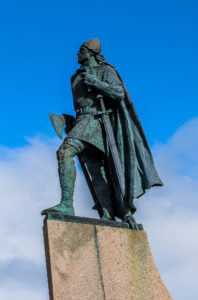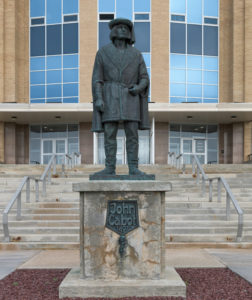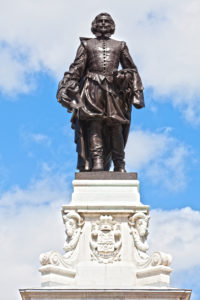Read the Following Selection
Read the following selection, or click on the play button below to listen aloud.
Three Explorers
Leif Erikson

Statue of Leif Erikson
Leif Erikson was a Viking explorer. He was born in Norway, but he grew up in Greenland. Many people believe Erikson was the first European explorer to land on the shores of North America.
In about the year 1000, Erikson and his crew sailed to North America to explore this land. The first place Erikson and his crew landed was covered with flat rocks, so they named the place Helluland (which means “Land of Flat Rocks”). Next, they sailed south and saw land covered with forests, so they named the area Markland (which means “Land of Forests”). Then, he and his crew continued sailing south. They came to a land with green fields where wild grapes grew, so they named the place Vinland. The name Vinland may mean “Land of Wine” (wine is made from grapes) or “Land of Meadows.”
So, where were these lands that Erikson named? No one knows for sure. Many people believe Helluland was on Baffin Island, which is part of Nunavut. Markland was probably in Labrador. Vinland might have been located in northern Nova Scotia.
John Cabot

John Cabot statue, St. John’s, Newfoundland and Labrador
John Cabot was an Italian explorer who was hired by the King of England to do two things—discover unknown lands that could be claimed for England, and search for a westward route for sailing to Asia to buy and sell goods. In 1497, Cabot sailed from England and reached North America. Some historians believe that Cabot first landed in southern Labrador or Northern Newfoundland. After that, he sailed south along the coast, probably to the Avalon Peninsula in western Newfoundland. At that point, he returned to England.
Based on Cabot’s journey, England claimed ownership of the land Cabot reached (North America). After Cabot reported that the coastal waters he sailed through were full of cod, these waters became known in Europe as an excellent place to send ships to fish.
Samuel de Champlain

Samuel de Champlain statue, Quebec city, Canada
Samuel de Champlain was an explorer and cartographer (a person who makes maps). He was born in France and made his first voyage to North America in 1603. After exploring the St. Lawrence River, he returned to France.
In 1604, the French king sent Champlain and others on a voyage to North America. The king wanted to establish French settlements in North America and make money through the fur trade. Champlain’s job was to help find a good place to create a French settlement. In 1605, a French settlement named Port-Royal was created in Nova Scotia. Champlain continued exploring until he and the settlers returned to France in 1607.
In 1608, Champlain travelled back to the St. Lawrence River and created a new French settlement called Québec. This settlement grew into what we now know as Québec City.
Now, show what you know!
Complete some questions about the reading selection by clicking “Begin Questions” below.









